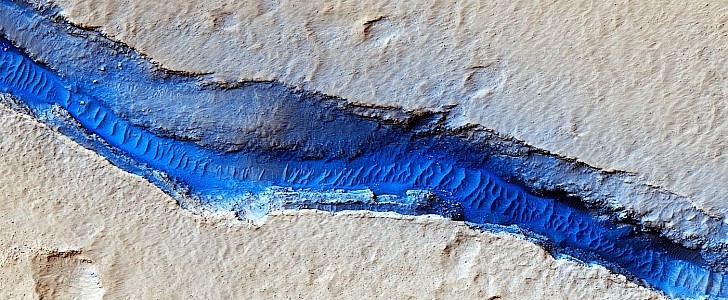It is very difficult for us spacefaring humans to imagine our neighboring planet Mars tinted blue by liquid water. That’s because all we see now are vast expanses of reddish or grayish soil, scarred by countless craters and adorned by alien features. But there was a time when the blue of the water was as real as the red of today over on Mars.
Contributing to the difficulty of imagining an at least partly blue Mars is the fact that, quite strangely given our fascination with the place, not many artists, be they writers, painters, or whatever, have ever tried imagining Mars with rivers and oceans. Luckily, modern-day technology (and some tricks of our brains) can help a bit with that.
What you’re looking at in the main photo of this piece is a slice of Mars captured by the HiRISE camera back in 2016, from an altitude of 275 km (171 miles). It’s a view of a place called Cerberus Fossae, in the southeastern region of Elysium Planitia, an area filled with “a series of discontinuous fissures” that makes it incredible to look at.
According to the people studying these images for a living, this “rift zone is thought to be the result of combined volcano-tectonic processes,” with dark sediment building up along the floor of the fissures, right beside aeolian bedforms.
The image shows a basaltic sand lining on the floor of such a rift, which thanks to the filters of the HiRISE camera, is shown here in deep blue. If you look at the image in a certain way, you can almost imagine that you’re looking at some alien river, snaking its way through the canyon it carved over eons.
In a sense, it is a river, but one made of sand, immobile because of the suspected lack of aeolian activity.
What you’re looking at in the main photo of this piece is a slice of Mars captured by the HiRISE camera back in 2016, from an altitude of 275 km (171 miles). It’s a view of a place called Cerberus Fossae, in the southeastern region of Elysium Planitia, an area filled with “a series of discontinuous fissures” that makes it incredible to look at.
According to the people studying these images for a living, this “rift zone is thought to be the result of combined volcano-tectonic processes,” with dark sediment building up along the floor of the fissures, right beside aeolian bedforms.
The image shows a basaltic sand lining on the floor of such a rift, which thanks to the filters of the HiRISE camera, is shown here in deep blue. If you look at the image in a certain way, you can almost imagine that you’re looking at some alien river, snaking its way through the canyon it carved over eons.
In a sense, it is a river, but one made of sand, immobile because of the suspected lack of aeolian activity.








